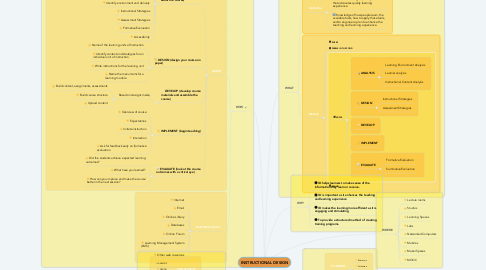
1. HOW
1.1. ADDIE
1.1.1. ANALYSIS (plan in advance about the course)
1.1.1.1. Design
1.1.1.2. Audience
1.1.1.3. Goal
1.1.1.4. Objectives
1.1.1.5. Identify content
1.1.1.6. Identify environment and delivery
1.1.1.7. Instructional Strategies
1.1.1.8. Assessment Strategies
1.1.1.9. Formative Evaluation
1.1.1.10. Accessibility
1.1.2. DESIGN (design your course on paper)
1.1.2.1. Name of the learning units of Instruction
1.1.2.2. Identify content and strategies for an individual unit of instruction
1.1.2.3. Write instructions for the learning unit
1.1.2.4. Name the menu items for a learning module
1.1.3. DEVELOP (develop course materials and assemble the course)
1.1.3.1. Based on designs made,
1.1.3.1.1. Build content, assignments, assessments
1.1.3.1.2. Build course structure
1.1.3.1.3. Upload content
1.1.4. IMPLEMENT (begin teaching)
1.1.4.1. Overview of course
1.1.4.2. Expectations
1.1.4.3. Initiate instruction
1.1.4.4. Interaction
1.1.4.5. Ask for feedback early on (formative evaluation
1.1.5. EVALUATE (look at the course outcomes with a critical eye)
1.1.5.1. Did the students achieve expected learning outcomes?
1.1.5.2. What have you learned?
1.1.5.3. How can you improve and make the course better in the next session?
1.2. TEACHING TOOLS
1.2.1. Internet
1.2.2. Email
1.2.3. Online Library
1.2.4. Databases
1.2.5. Online Forum
1.2.6. Learning Management System (LMS)
1.2.7. Other web resources
2. WHEN
2.1. PRE-LESSON
2.1.1. ANALYSIS
2.1.2. DESIGN
2.1.3. DEVELOP
2.2. DURING LESSON
2.2.1. IMPLEMENT
2.3. POST-LESSON
2.3.1. EVALUATE
3. WHAT
3.1. Definition
3.1.1. It is a systematic process, based on educational theories, on development of instructional strategies, and specifications that advocates quality learning experience.
3.1.2. Knowledge of how people learn, the available tools, how to apply those tools, and to engineer a plan to enhance the teaching and learning experience.
3.2. Models
3.2.1. ROPES
3.2.2. PEBBLE IN THE POND
3.2.3. ADDIE
3.2.3.1. ANALYSIS
3.2.3.1.1. Learning Environment Analysis
3.2.3.1.2. Learner analysis
3.2.3.1.3. Instructional Content Analysis
3.2.3.2. DESIGN
3.2.3.2.1. Instructional Strategies
3.2.3.2.2. Assessment Strategies
3.2.3.3. DEVELOP
3.2.3.4. IMPLEMENT
3.2.3.5. EVALUATE
3.2.3.5.1. Formative Evaluation
3.2.3.5.2. Summative Evaluation
3.2.4. GAGNE
4. WHY
4.1. ID helps learners to make sense of the information they learn or receive.
4.2. ID is important as it enhances the teaching and learning experience
4.3. ID makes the learning more efficient as it is engaging and stimulating
4.4. To provide a structured method of creating training programs.
5. WHO
5.1. PLANNER
5.1.1. Educators
5.1.2. Facilitators
5.1.3. Instructors
5.2. RECEIVER
5.2.1. Learners
